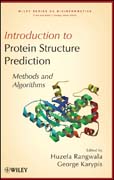
A thorough knowledge of the function and structure of proteins is critical for the advancement of biology and the life sciences as well as the development of better drugs, higher-yield crops, and even synthetic bio-fuels. To that end, this reference sheds light on the methods used for protein structure prediction and reveals the key applications of modeled structures. This indispensablebook covers the applications of modeled protein structures and unravels the relationship between pure sequence information and three-dimensional structure,which continues to be one of the greatest challenges in molecular biology INDICE: 1. Introduction to Protein Structure Prediction. 2. CASP: a driving force in protein structure modeling. 3. The Protein Structure Initiative. 4.Prediction of one-dimensional structural properties of proteins by integratedneural networks. 5. Local Structure Alphabets. 6. Shedding light on transmembrane topology. 7. Contact Map Prediction by Machine Learning. 8. A survey of remote homology detection and fold recognition methods. 9. Integrative Protein Fold Recognition by Alignments and Machine Learning. 10. TASSER-based protein structure prediction. 11. Composite approaches to protein tertiary structure prediction: A case-study by I-TASSER. 12. Hybrid Methods for Protein Structure Prediction. 13. Modeling loops in protein structures. 14. Model quality assessment using a statistical program that adopts a side-chain environment viewpoint. 15. Model Quality Prediction. 16. Ligand-binding Residue. 17. Modeling and validation of transmembrane protein structures. 18. Structure-based machine learning models for computational mutagenesis. 19. Conformational Search the protein native-state. 20. Modeling Mutations in Proteins Using Medusa and Discrete Molecule Dynamics.
- ISBN: 978-0-470-47059-6
- Editorial: John Wiley & Sons
- Encuadernacion: Cartoné
- Páginas: 536
- Fecha Publicación: 10/12/2010
- Nº Volúmenes: 1
- Idioma: Inglés
